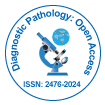Characters of Mesothelioma are Changeable
Received: 28-Dec-2020 / Accepted Date: 04-Jan-2021 / Published Date: 11-Jan-2021 DOI: 10.4172/2476-2024.1000180
Abstract
One of the histological features of mesothelioma is co-existence of heterogeneous components in the same tumor. Biphasic subtype of mesothelioma is defined by the criteria that each of epithelioid and sarcomatoid components represent at least 10% of the tumor.
Keywords: Mesothelioma; Epithelioid; Sarcomatoid
About the Study
One of the histological features of mesothelioma is co-existence of heterogeneous components in the same tumor. Biphasic subtype of mesothelioma is defined by the criteria that each of epithelioid and sarcomatoid components represent at least 10% of the tumor [1], and biphasic mesothelioma accounts for 20%-35% of all pleural mesothelioma [2]. It means that, if the criteria of "at least 10%" is not concerned, more than 20%-35% of mesothelioma contains two components. We consider this co-existence of epithelioid and sarcomatoid components is a significant character of mesothelioma, because it is known that prognosis of sarcomatoid mesothelioma is worse than that of epithelioid one [3] and that proliferative activity of sarcomatoid cell is higher than that of epithelioid one [4]. Why is less aggressive epithelioid cell not completely replaced by more aggressive sarcomatoid one? The maintenance of heterogeneity seems to give some advantages to mesothelioma for its survival. The heterogeneity may make mesothelioma more evasive from host immune system, and more intractable to the medical treatments. There should be the mechanisms to keep this heterogeneity.
Our recent report showed that the mesothelial cells with monophasic and spindle-shaped morphology in the culture formed mesothelioma containing both spindle-shaped and polygonal components in mouse xenograft model, and this result suggested the reversibility of histological subtypes of mesothelioma, between epithelioid and sarcomatoid ones [4]. Although we have not proved the reversibility, several findings are compatible with our idea. Normal mesothelial cells are known to have the ability to change their phenotypes, and to behave as multipotent cells [5]. It is possible that the multipotency is maintained even after the acquirement of malignant potency. Mossman also hinted reversibility of characters in mesothelioma by epigenetic changes [6]. Mesothelioma is more fluid and changeable than other solid tumors, and this reversibility keeps the heterogeneity.
References
- Galateau-Salle F, Dacic S, Ordonez NG, Churg A, Hammar S, et al. Epithelioid mesothelioma. (2015) WHO classification of tumours of the lung, pleura, thymus and heart. Lyon: Â 156-164.
- Eltorky M (2015) Diffuse Malignant Mesothelioma. New York: Springer 4: 69-91.
- Yap TA, Aerts JG, Popat S, Fennell DA (2017) Novel insights into mesothelioma biology and implications for therapy. Nature Reviews Cancer 17: 475-488.
- Kojima M, Kajino K, Momose S, Wali N, Hlaing MT, et al. (2020) Possible reversibility between epithelioid and sarcomatoid types of mesothelioma is independent of ERC/mesothelin expression. Respiratory Research 21: 187.
- Rinkevich Y, Mori T, Sahoo D, Xu P-X, Bermingham JR, et al. (2012) Identification and prospective isolation of a mesothelial precursor lineage giving rise to smooth muscle cells & fibroblasts for mammalian internal organs, and their vasculature. Nat Cell Biol 14: 1251-1260.
- Mossman BT (2017) Cell Signaling and Epigenetic Mechanisms in Mesothelioma. Asbestos and Mesothelioma 10: 211-235.
Copyright: © 2021 Kajino K, et al. This is an open-access article distributed under the terms of the Creative Commons Attribution License, which permits unrestricted use, distribution, and reproduction in any medium, provided the original author and source are credited.
